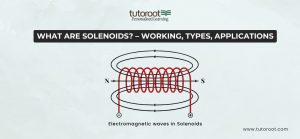What are Solenoids? – Working, Types, Applications
Introduction
In the world of physics, solenoids are fascinating devices that play a crucial role in converting electrical energy into mechanical motion. They are widely used in various applications, from simple doorbells to complex industrial machinery. But what exactly are solenoids, how do they work, and what types exist? This article aims to provide a comprehensive understanding of solenoids, their working principles, types, and applications, making the concept accessible even to students.
What are Solenoids?
Solenoids are a type of electromagnet, a device that converts electrical energy into a magnetic field. At its core, a solenoid consists of a coil of wire, usually wound into a helix shape, with an electric current passing through it. As electric current passes through the wire, a magnetic field is generated within the coil, effectively transforming the solenoid into an electromagnet.
Definition of Solenoids: A solenoid is a coil of wire designed to generate a magnetic field when an electric current passes through it. The magnetic field produced by the solenoid can be used to move a metal core (also known as a plunger) inside the coil, creating linear motion.
Explanation of Solenoids: The basic structure of a solenoid includes a tightly wound coil of wire, often made of copper, which is known for its excellent conductivity. The coil is wrapped around a cylindrical tube, usually made of non-magnetic material like plastic, to support the coil and allow the magnetic field to concentrate within the cylinder. The solenoid becomes magnetized when an electric current is passed through the coil, creating a uniform magnetic field inside the tube.
The strength of the magnetic field generated by the solenoid depends on factors such as the number of turns in the coil, the strength of the current, and the permeability of the material inside the coil. Solenoids come in different shapes and sizes and are utilized in numerous applications because of their precise control over motion.

Working of Solenoids
The working principle of solenoids is rooted in electromagnetism. When electric current passes through a solenoid’s coil, it produces a magnetic field aligned with the coil’s axis. This magnetic field is concentrated within the coil, creating a strong magnetic force that can move a metal core (plunger) placed inside the coil.
Step-by-Step Working Process:
- Electric Current and Magnetic Field: When an electric current flows through the solenoid’s wire, a magnetic field is generated inside the coil. The direction of the magnetic field follows the right-hand rule, where the fingers curl in the direction of current flow, and the thumb points in the direction of the magnetic field.
- Magnetic Force and Plunger Movement: The magnetic field generated inside the solenoid exerts a force on the metal core (plunger) placed within the coil. This force pulls the plunger towards the center of the solenoid, creating linear motion. The plunger moves to minimize the magnetic field’s reluctance, which is the opposition to the magnetic flux.
- Control of Motion: The motion of the plunger can be controlled by adjusting the strength of the electric current. A stronger current generates a stronger magnetic field, resulting in greater force and faster movement of the plunger. Conversely, reducing the current decreases the magnetic force, slowing down or stopping the plunger’s motion.
- Return Mechanism: In most solenoids, a spring is used to return the plunger to its original position when the current is turned off. This return mechanism ensures that the solenoid can be used repeatedly in applications where precise control of motion is required.
- Continuous or Pulse Operation: Solenoids can operate in either continuous or pulse mode. In continuous mode, the current is kept on for an extended period, holding the plunger in position. In pulse mode, a brief current pulse moves the plunger, which then returns to its original position after the pulse ends.
Detailed Example: Consider a solenoid used in an electric door lock. When a current flows through the solenoid, the magnetic field pulls the plunger, unlocking the door. Once the current stops, the spring returns the plunger to its original position, locking the door again. This simple yet effective mechanism is a common example of how solenoids are used in everyday applications.
The efficiency and reliability of solenoids make them indispensable in various fields, including automotive systems, industrial automation, and consumer electronics. Their ability to convert electrical signals into mechanical motion allows for precise control in devices that require rapid and accurate movement.
Types of Solenoids
Solenoids come in different types, each designed for specific applications. The classification is often based on the design, operation, and intended use of the solenoid.
- Linear Solenoids: Linear solenoids are the most common type, designed to produce linear motion. They consist of a coil of wire with a movable plunger inside. When current flows through the coil, the plunger moves linearly, either pulling in or pushing out, depending on the design.
Description: Linear solenoids are commonly employed in situations that demand accurate linear motion control, such as door locks, vending machines, and fuel injectors. They are preferred for their straightforward design and dependability.
- Rotary Solenoids: Unlike linear solenoids, rotary solenoids produce rotational motion instead of linear motion. They consist of a coil of wire and a rotor attached to a shaft. When current flows through the coil, the rotor rotates, creating angular motion.
Description: Rotary solenoids are commonly used in applications that require rotational motion, such as in valve actuators, rotary switches, and electromechanical clutches. They offer a compact solution for controlling rotational movement.
- Hydraulic Solenoids: Hydraulic solenoids are designed to control the flow of hydraulic fluids in systems like hydraulic pumps and valves. They consist of a solenoid-operated valve that regulates fluid flow based on the current supplied to the solenoid.
Description: Hydraulic solenoids are used in heavy machinery, automotive systems, and industrial automation where precise fluid flow control is essential. They offer high force and durability, making them suitable for demanding environments.
- Pneumatic Solenoids: Similar to hydraulic solenoids, pneumatic solenoids control air flow in pneumatic systems. They are used in applications like air compressors, pneumatic actuators, and air tools, where controlling air pressure and flow is crucial.
Description: Pneumatic solenoids are essential in industries that rely on compressed air for operation. They offer fast response times and are used in systems where rapid and precise control of air flow is required.
Applications of Solenoids
Solenoids are versatile devices with a wide range of applications across various industries. Their ability to convert electrical energy into mechanical motion makes them ideal for tasks requiring precise control and automation.
Common Applications:
- Automotive Industry: Solenoids are used in car engines for fuel injection, starter motors, and automatic transmissions. They play a crucial role in controlling the movement of components within the engine.
- Consumer Electronics: In devices like printers, DVD players, and vending machines, solenoids are used to control mechanical parts, such as paper feeds and disc trays, ensuring smooth operation.
- Industrial Automation: Solenoids are widely used in automated machinery, controlling valves, actuators, and other components to ensure precise and efficient operation in manufacturing processes.
- Medical Equipment: Solenoids are used in medical devices like MRI machines and ventilators, where precise control of movement and operation is essential for patient care.
Final Notes
Solenoids are integral to modern technology, offering precise control over mechanical motion in various applications. Their simple yet effective design, coupled with their versatility, makes them indispensable in fields ranging from automotive engineering to industrial automation. Understanding the working principles, types, and applications of solenoids can provide valuable insights into the role of electromagnetism in everyday life.
If you found this explanation helpful and want to deepen your understanding, be sure to explore more topics on the Tutoroot Blog. Tutoroot offers expert online tutoring that makes even the most challenging subjects easy to grasp. Ready to excel in your studies? Try Tutoroot’s Physics Online Tuition with a FREE DEMO session and experience personalized learning tailored to your needs.
FAQs
What are solenoids used for?
Solenoids are used to convert electrical energy into mechanical motion, controlling devices such as valves, actuators, and switches in various applications, including automotive systems, consumer electronics, and industrial automation.
What are Electric solenoids?
Electric solenoids are devices that use an electric current to generate a magnetic field, which in turn creates mechanical motion. They are commonly used in applications requiring precise control of linear or rotational movement.
Define Solenoid Magnet
A solenoid magnet refers to the magnetic field generated by a solenoid when an electric current flows through its coil. This magnetic field is concentrated within the solenoid and is used to create motion in the solenoid’s plunger or rotor.
What is meant by solenoid coils?
Solenoid coils refer to the tightly wound wire coil in a solenoid, responsible for generating the magnetic field when an electric current passes through it. The number of turns in the coil and the strength of the current determine the strength of the magnetic field.
What are solenoid switches?
Solenoid switches are devices that use a solenoid to control the opening and closing of electrical circuits. These devices are employed in a range of applications, including vehicle starter motors and the management of high-power circuits in industrial settings.

